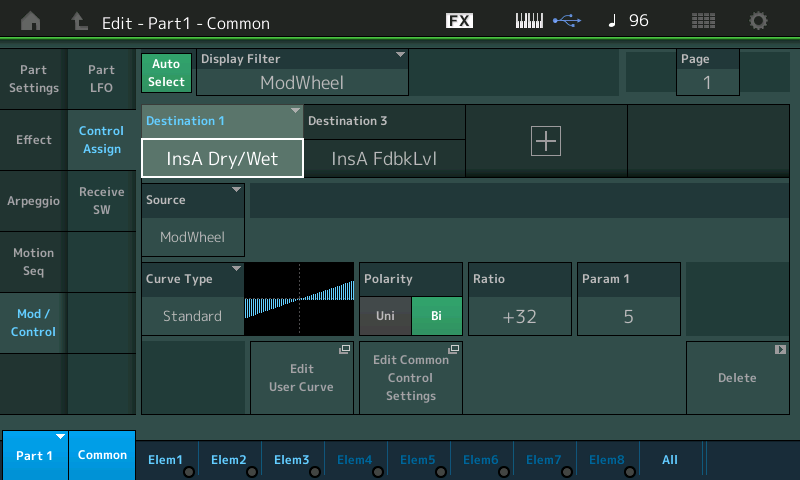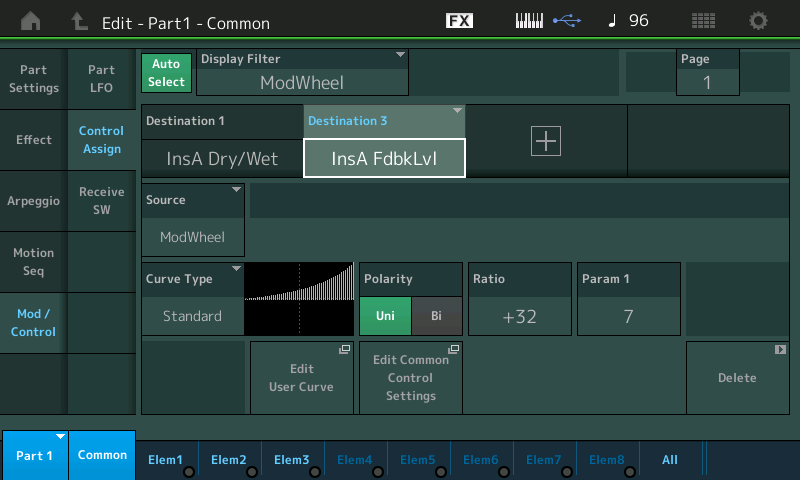I have this Performance* set up so that when ASSIGN 1 is off, you don’t hear the delay effect, and when ASSIGN 1 is on, you do hear the delay effect,
I start with the switch off, and play for a while. Then I turn the switch on to use the delay effect. As I do that, there’s a burst of sound as if the delay effect has been storing up notes behind the scenes, and now it releases them.
Is there a way to keep this from happening? Why is it happening?
Thanks…
* It’s a newer version of the Performance from the other thread, so make sure to download this one in reference to this post.
I have this Performance* set up so that when ASSIGN 1 is off, you don’t hear the delay effect, and when ASSIGN 1 is on, you do hear the delay effect,
I start with the switch off, and play for a while. Then I turn the switch on to use the delay effect. As I do that, there’s a burst of sound as if the delay effect has been storing up notes behind the scenes, and now it releases them.
Is there a way to keep this from happening? Why is it happening?
Thanks…
In this version both [AsSw1] and AsgnKnob7 are controlling the “InsA FdbkLvl” — this conflict makes it difficult to control the “Tempo Delay Stereo”. Particularly, so when Feedback… once the Feedback grabs a bit of input it keeps them ready to release to accommodate the number of repeats requested. The AsSw causes the Feedback to go from its minimum to its maximum immediately (it’s now a switch), the AsgnKnob7 allows the number of repeats to be increased gradually and brought back to its starting point depending on the position of the Knob.
The Dry/Wet parameter - when all the way Dry, this allows just the signal pass (no echo), when all the way Wet, the original notes are not heard only the echoes.
How to Approach Untangling Assignments
Immediately we can see the changes you made, by going to “Part 1” > [EDIT] and studying the “Mod/Control” > “Control Assign” screen with the “Display Filter” set to ”All”.
Destination 1 is the AsgnKnob7 controlling “InsA FdbkLvl”
Destination 3 is the [AsSw1] controlling “InsA FdbkLvl”
The Feedback conflict is creating a build up of data (it’s an eighth note worth of data) that gets released when you slam Dry to Wet and Feedback to maximum, by hitting the [AsSw1]
Move the cursor to view “Destination 3” — tap “Delete” in the lower right corner. That will prevent this from happening.
I did the thing with ASSIGN 1 because even with parameters turned all the way down, I was still getting at least one repeated note from the delay effect. ASSIGN 1 was my attempt to stop that from happening when I didn’t want it.
Can you suggest a better way to turn the delay effect all the way off when that’s what I want?
Can you suggest a better way to turn the delay effect all the way off when that’s what I want?
I wasn’t quite sure what you wanted to accomplish.
I would use a continuous value controller rather than setting up ‘switch’.
By manipulating the Dry/Wet balance such that when the controller is at minimum you will hear Dry (no echoes), as you increase that controller, using the Standard Curve, you will be increasing the level of the repeats. The balance will get more and more toward Wet the higher you go. You can ‘shape’ how the Dry/Wet balance changes by adjusting the “Param 1” setting.
By also assigning the Feedback Level (number of repeats) to the same controller, when that controller is at minimum there will be no echoes (we already have ensured that with the Dry/Wet balance), but as you raise the controller you will be increasing the number of repeats. This is critical… you can ‘shape’ how the number of eighth note echoes increases as you move the control (continuous).
See these two Control Assign setups below… I chose the MW because it’s a minimum-to-maximum controller, that defaults to minimum. You can, of course, chose another controller, if you prefer.


Use the “Param 1” to influence just how far you need to move the MW to get the amount of Feedback you want. The higher the # in “Param 1” the later in the MW movement for more repeats. The lower the # the quicker (earlier in the MW movement) the repeats build up.
See attached zip: Motion Wah Guitar MW.zip below
Can you suggest a better way to turn the delay effect all the way off when that’s what I want?
I wouldn't put this in the "better" category necessarily because I'm not sure if it works against other goals you have - but it's something that seems to do what you've explained:
Use two Parts and switch between them using a button. One Part would have the delay effect and the other would not. If you wanted previously triggered notes to keep their effect you could use an assignable switch (A.SW1 or A.SW2) and use this for XA-control on both Parts. When a switch is ON the first Part (with delay effect) can have the elements triggered by piano keys and second Part (with no delay effect) could not trigger elements as a result of key presses (ignore presses). This is similar to any other way to switch between two sets of sounds using A.SW(1,2) and these two Parts are the same except for having delay on one and no delay on the other.
If you want the effect to go away more instantaneously then Mute can be used. Program scene 1 to mute the 2nd Performance and scene 2 mute the 1st Performance. In this case, the delay would instantaneously shut off. The other property of this method is you could switch back to scene 1 (after going scene 1 to scene 2 and back to scene 1) and the effect for the same held notes would turn on and off and on again. This would mimic having a delay pedal that was bypassed with a switch (true bypass).
Instead of using scene buttons, you may be able to use A.SW(1 or 2) not in XA control but as part of motion control (mod control, control assign) as a source for the volume destination on each of the Parts. This is the same general idea as mute but uses volume instead of the dedicated Mute "button" allowing for more choices for source controllers.
A downside of either true mute or simulated mute is that these two approaches will consume more polyphony. Which means the benefit of using XA control is that you limit the amount of simultaneous elements "running" at the same time to a greater degree.
Of course the general downside of either of these is consumption of an extra "almost duplicate" Part.
Current Yamaha Synthesizers: Montage Classic 7, Motif XF6, S90XS, MO6, EX5R
